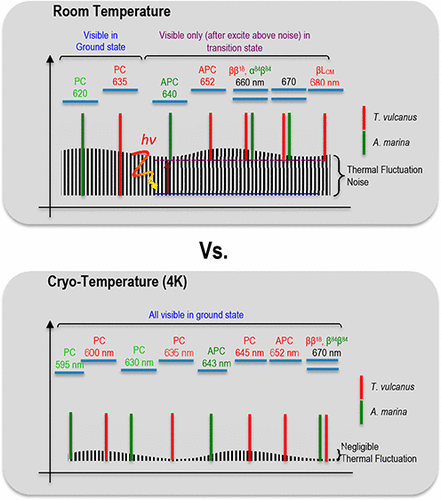当前位置:
X-MOL 学术
›
J. Phys. Chem. B
›
论文详情
Our official English website, www.x-mol.net, welcomes your
feedback! (Note: you will need to create a separate account there.)
Cryospectroscopy Studies of Intact Light-Harvesting Antennas Reveal Empirical Electronic Energy Transitions in Two Cyanobacteria Species
The Journal of Physical Chemistry B ( IF 2.8 ) Pub Date : 2018-02-19 00:00:00 , DOI: 10.1021/acs.jpcb.8b00714 Collins Nganou 1 , Noam Adir 2 , Martin Mkandawire 1
The Journal of Physical Chemistry B ( IF 2.8 ) Pub Date : 2018-02-19 00:00:00 , DOI: 10.1021/acs.jpcb.8b00714 Collins Nganou 1 , Noam Adir 2 , Martin Mkandawire 1
Affiliation

|
Understanding of electronic energy transition (EET) mechanisms from the light-harvesting unit to the reaction center in a natural system has been limited by (a) the use of conventional transient time-resolved spectroscopy at room temperature, which result in high signal-to-noise ratio and (b) examining extracts instead of intact light-harvesting units. Here, we report previously unknown differences and new insight in EET of two cyanobacteria species, Acaryochloris marina and Thermosynechoccocus vulcanus, which have been found only after using UV–vis, hole-burning, and fluorescence spectroscopy at ultralow temperature and examining their intact light-harvesting unit, phycobilisomes (PBS). Although the exciton formation is similarly induced by photoexcitation of chromophore assemblies in phycocyanin (PC) and allophycocyanin (APC) in PBSs of both species, the EET mechanisms are totally different, being adiabatic in A. marina and nonadiabatic in T. vulcanus. The PBS of A. marina has only one APC trimer and energy transfer is through coupling of α84 in APC with β84 in adjacent PC. In T. vulcanus, the PBS has three components: coupling between APC core and the entire PC rod and couplings of β–β18 and of LCM to β in the adjacent APC-like trimer. A total of 80% of the excitation energy is trapped in the coupling β–β18 and regulates the flow of energy from the high- to low-level terminal electronic transition emitter β-LCM. All these details cannot be observed at room temperature and in extracted units.
中文翻译:

完整的集光天线的低温光谱学研究揭示了两种蓝细菌物种的经验电子能跃迁。
对自然系统中从光收集单元到反应中心的电子能量转换(EET)机制的理解受到以下因素的限制:(a)在室温下使用常规的瞬态时间分辨光谱法,这导致了较高的信号-噪声比和(b)检查提取物而不是完整的光收集单元。在这里,我们报告以前未知的差异和两个蓝藻物种,无毒的盐藻和嗜热嗜热球菌的EET的新见解。,只有在超低温下使用紫外线可见光,孔燃烧和荧光光谱法并检查其完整的光收集单元藻胆体(PBS)后才发现。虽然激子形成类似地由在藻青素(PC)的发色团组件激发和别藻蓝蛋白(APC)在这两个物种的诱导的PBS中,EET机制是完全不同的,是在绝热A.码头和非绝热在T. vulcanus。的PBS A.码头仅具有一个APC三聚体和能量转移是通过α的耦合84与β在APC 84在相邻的PC。在T. vulcanus中,PBS具有三个分量:APC芯和整个PC杆和β-β的联接器之间的耦合18和L的CM,以在相邻的APC状三聚体β。共有的激发能量的80%的被捕获在耦合β-β 18和调节能量从高到低级别的终端电子跃迁发射β-L流动CM。所有这些细节都无法在室温和抽出的单位中观察到。
更新日期:2018-02-19
中文翻译:

完整的集光天线的低温光谱学研究揭示了两种蓝细菌物种的经验电子能跃迁。
对自然系统中从光收集单元到反应中心的电子能量转换(EET)机制的理解受到以下因素的限制:(a)在室温下使用常规的瞬态时间分辨光谱法,这导致了较高的信号-噪声比和(b)检查提取物而不是完整的光收集单元。在这里,我们报告以前未知的差异和两个蓝藻物种,无毒的盐藻和嗜热嗜热球菌的EET的新见解。,只有在超低温下使用紫外线可见光,孔燃烧和荧光光谱法并检查其完整的光收集单元藻胆体(PBS)后才发现。虽然激子形成类似地由在藻青素(PC)的发色团组件激发和别藻蓝蛋白(APC)在这两个物种的诱导的PBS中,EET机制是完全不同的,是在绝热A.码头和非绝热在T. vulcanus。的PBS A.码头仅具有一个APC三聚体和能量转移是通过α的耦合84与β在APC 84在相邻的PC。在T. vulcanus中,PBS具有三个分量:APC芯和整个PC杆和β-β的联接器之间的耦合18和L的CM,以在相邻的APC状三聚体β。共有的激发能量的80%的被捕获在耦合β-β 18和调节能量从高到低级别的终端电子跃迁发射β-L流动CM。所有这些细节都无法在室温和抽出的单位中观察到。











































 京公网安备 11010802027423号
京公网安备 11010802027423号